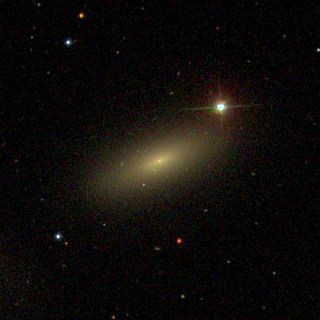
NGC 7010 is a massive elliptical galaxy located about 365 million light-years from Earth in the constellation Aquarius. NGC 7010 was discovered by astronomer John Herschel on August 6, 1823, and was later listed by French astronomer Guillaume Bigourdan as IC 5082.

NGC 7033 is a lenticular galaxy located about 390 million light-years away in the constellation of Pegasus. It is part of a pair of galaxies that contains the nearby galaxy NGC 7034. NGC 7033 was discovered by astronomer Albert Marth on September 17, 1863.

NGC 7034 is an elliptical galaxy located about 380 million light-years away in the constellation of Pegasus. It is part of a pair of galaxies that contains the nearby galaxy NGC 7033. NGC 7034 was discovered by astronomer Albert Marth on September 17, 1863.

NGC 7042 is a spiral galaxy located about 210 million light-years away in the constellation of Pegasus. NGC 7042 is part of a pair of galaxies that contains the galaxy NGC 7043. Astronomer William Herschel discovered NGC 7042 on October 16, 1784.

NGC 7043 Is a barred spiral galaxy located about 200 million light-years away in the constellation of Pegasus. NGC 7043 is part of a pair of galaxies that contains the galaxy NGC 7042. It has an estimated diameter of 73,100 light-years. NGC 7043 was discovered by astronomer Albert Marth on August 18, 1863.

NGC 7053 is a spiral galaxy located about 200 million light-years away in the constellation of Pegasus. It was discovered by astronomer Albert Marth on September 2, 1863. It was then rediscovered by astronomer Heinrich d'Arrest on October 8, 1865.

NGC 7056 is a barred spiral galaxy located about 225 million light-years away in the constellation of Pegasus. NGC 7056 was discovered by astronomer Albert Marth on September 17, 1863. It was then rediscovered by astronomer Truman Henry Safford on September 29, 1866.

NGC 7060 is an intermediate spiral galaxy located about 200 million light-years away in the constellation of Microscopium. The spiral arms of NGC 7060 appear to overlap. NGC 7060 was discovered by astronomer John Herschel on September 2, 1836.

NGC 7066 is a spiral galaxy located about 210 million light-years away in the constellation of Pegasus. NGC 7066 was discovered by astronomer Lewis Swift on August 31, 1886.
NGC 7070 is a spiral galaxy located about 100 million light-years away in the constellation of Grus. It has a close companion galaxy called NGC 7070A. NGC 7070 was discovered by astronomer John Herschel on September 5, 1834.

NGC 7074 is an edge-on lenticular galaxy located about 140 million light-years away in the constellation of Pegasus. NGC 7074 was discovered by astronomer Albert Marth on October 16, 1863.

NGC 7085 is a spiral galaxy located about 365 million light-years away in the constellation of Pegasus. NGC 7085 was discovered by astronomer Albert Marth on August 3, 1864.

NGC 7096 is a grand-design spiral galaxy located about 130 million light-years away in the constellation of Indus. NGC 7096 is also part of a group of galaxies that contains the galaxy NGC 7083. NGC 7096 was discovered by astronomer John Herschel on August 31, 1836.

NGC 4461 is a lenticular galaxy located about 50 million light-years away in the constellation of Virgo. It was discovered by astronomer William Herschel on April 12, 1784. NGC 4461 is a member of Markarian's Chain which is part of the Virgo Cluster.

NGC 4489 is a dwarf elliptical galaxy located about 60 million light-years away in the constellation of Coma Berenices. It was discovered by astronomer William Herschel on March 21, 1784. NGC 4489 is a member of the Virgo Cluster.

NGC 4606 is a spiral galaxy located about 55 million light-years away in the constellation of Virgo. NGC 4606 was discovered by astronomer William Herschel on March 15, 1784. It has a disturbed stellar disk suggesting the actions of gravitational interactions. NGC 4607 may be a possible companion of NGC 4606. However, their redshifts differ by about 600 km/s, making it unlikely that they are a gravitationally bound pair. NGC 4606 is a member of the Virgo Cluster.

NGC 4436 is a lenticular or dwarf elliptical galaxy located about 60 million light-years away in the constellation of Virgo. NGC 4436 was discovered by astronomer William Herschel on April 17, 1784. The galaxy is a member of the Virgo Cluster.

NGC 4476 is a lenticular galaxy located about 55 million light-years away in the constellation Virgo. NGC 4476 was discovered by astronomer William Herschel on April 12, 1784. The galaxy is a member of the Virgo Cluster.

NGC 4478 is an elliptical galaxy located about 50 million light-years away in the constellation Virgo. NGC 4478 was discovered by astronomer William Herschel on April 12, 1784. NGC 4478 is a member of the Virgo Cluster.

NGC 4503 is a barred lenticular galaxy located around 41 to 74 million light-years away in the constellation Virgo. NGC 4503 was discovered by astronomer William Herschel on March 15, 1784. NGC 4503 is a member of the Virgo Cluster.



















